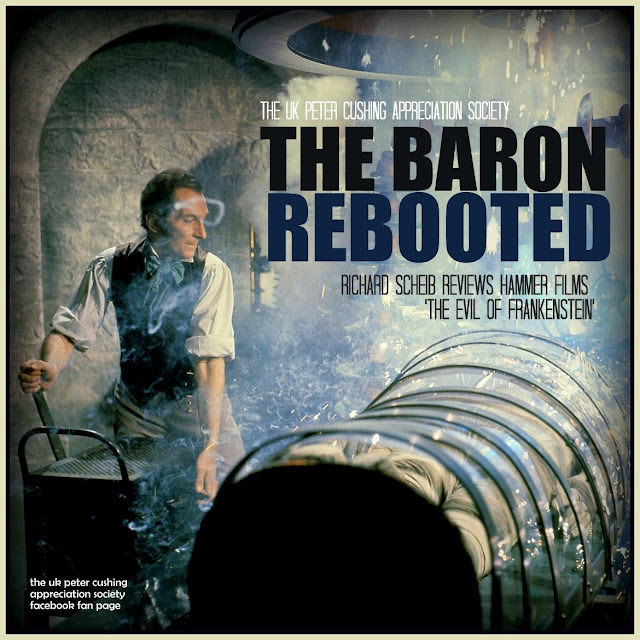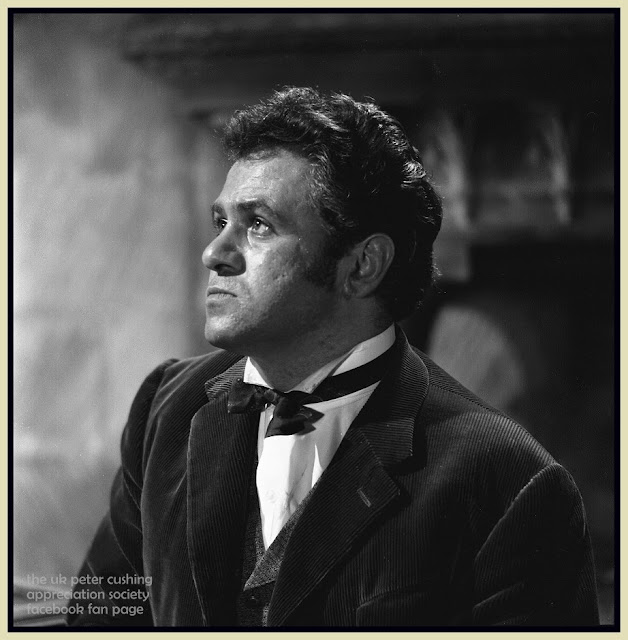“A FACE DA CORRUPÇÃO” – BAIXARIA OU QUALIDADE?
Chavões, sensacionalismo, visual banal. Não dá pra negar que
este veículo para Peter Cushing dirigido pelo especialista em apelação Robert
Hartford-Davis em 1967 tem isso tudo. Também não dá pra negar que o filme é uma
experiência única e poderosa, nem por aqueles que detestam sua força. Por que?

A trama: Sir John Rowan, um cirurgião brilhante, tem que
matar pessoas periodicamente para extrair delas um soro capaz de restaurar o
rosto desfigurado de sua noiva – um clichê de filme de horror (“Raptor de
Noivas”, 1942, um filme B da Monogram com Bela Lugosi, é um exemplo) executado
com a mesma ênfase em cirurgia explícita vista pouco antes no respeitado “Os Olhos sem Rosto”(1959) de Georges Franju,
e já imitado no não-tão-respeitado “O Terrível Dr. Orloff” (1962), de Jesus
Franco. Sir John sai por aí carregando uma maletinha de instrumentos médicos a la
Jack, o Estripador e matando mulheres. Depois de um final explosivo, o filme,
aparentemente por falta de solução melhor, plagia o epílogo de outro clássico, “Na
Solidão da Noite” (1945), da Ealing.

Partindo dessa plataforma surrada, o roteiro de Donald e
Derek Ford – que já tinham abordado Jack, o Estripador no ótimo “Névoas do
Terror” (1965), em que o famigerado assassino vitoriano encontra Sherlock
Holmes – se concentra em seus próprios interesses. Pra começar, caracterização
e nuances psicológicas. Sir John é um caso clínico de perfeccionismo
patológico. Antes dos créditos iniciais terminarem, nós o vemos suando na mesa
de operações, comentando que “quanto mais sucessos, mais se temem as falhas” e
cochilando numa biblioteca abarrotada dominada por um busto imponente – dele? -
à meia-luz, com um livro ainda aberto em
seu colo.

Muitos reclamam que não faz sentido ele se apaixonar pela
vaidosa e desagradável Lynn Nolan (Sue Lloyd, da série de TV “The Baron”). Vem
cá, admitindo que esse solteirão travado de meia-idade não chegou aonde está
sem uma bela dose de renúncia pessoal, o amor de uma linda modelo muito mais
jovem que ele bastaria pra deixá-lo bobo (“obcecado” por ela, diz seu colega
Dr. Harris, com razão). Não só ele está indo atrás do tempo perdido, mas ela é
um troféu, outro “sucesso” em sua carreira. Quando o rosto dela é queimado num
acidente por culpa dele, não há do que não seja capaz para resgatá-la.
Ele não precisa matar mulheres desejáveis. É escolha.
Pode-se argumentar que são mais fáceis de dominar que um homem, mas quando a
vítima em questão é uma garota mais jovem cuja vida ainda não é “perdida”, ele
resiste. “Jurei preservar a vida, não tirá-la”, ele diz, o rosto subitamente
iluminado por um abajur. Presume-se que uma vida inteira de contenção alimentou
uma agressividade contra mulheres sexualmente excitantes. O filme não é
misógino, o protagonista sim.

Quanto a Lynn, nem o roteiro nem a atriz força a mão em seu
papel de mulher fatal como, digamos, Hazel Court nas adaptações de Poe feitas
por Roger Corman. Acreditamos em seu tormento físico e emocional (“Gente
virando o rosto quando me vê...” Ela é modelo! Os diálogos têm a inteligência
de aproveitar a experiência profissional e de vida dos personagens para
intensificar o drama) e ela parece sincera quando diz que escolheu John pelo “homem”,
não o título ou o dinheiro. Steve Harris é um achado. Herói nominal do filme,
ele é bastante esperto para descobrir as ações e entender os motivos de John,
mas sua impertinência de Grilo Falante é ineficaz, e quando ele finalmente age
no clímax, faz de modo tão equivocado e desastrado que precipita a catástrofe.
De uma tacada, os realizadores criam um personagem verossímil, subvertem um
clichê básico e fazem um desaforo aos moralistas e censores.
O filme dá novo sentido à história velha ancorando-a
firmemente na realidade e ambientes prosaicos da “swinging London”, resultando
principalmente num contraste entre o velho mundo representado por Sir John e o
panorama emergente nos anos 60. O último ato, quando a casa é invadida por “beatniks”
(uma apropriação menos evidente, esta de “O Tesouro de Sierra Madre”, de John
Huston, mas totalmente filtrada e legitimada) é notável por mostrar cada grupo
horrorizado com o outro. O loucão Groper (David Lodge, conhecido pela série
cinematográfica “Carry On”) é uma paródia diabólica e corpulenta de John Lennon
usando um uniforme de Sgt. Pepper, só que preto, sugerindo o lado destrutivo da
vida pé na estrada. Curiosamente, Corman tinha feito o mesmo de forma diferente
em “O Segredo Negro” (1959).

Um filme tão focado na erupção de instintos violentos em
contextos diversos não poderia ser encenado de forma suave. Sua agressividade
tem razão de ser, assim como os ambientes derrubados e ordinários.
Hartford-Davis se aproxima tanto quanto possível dos princípios expressionistas
sem fugir desses limites na grotesca distorção do semblante e do entorno do
protagonista pela lente grande-angular; na sequência de abertura com os médicos
mascarados e os equipamentos se fundindo num único mecanismo; e na imagem final
- o perturbador close dos olhos de Peter com os gritos das mulheres como trilha
sonora. A última sequência funciona menos para nos pegar com um final-surpresa
que para realçar o desequilíbrio potencial de John.O mesmo cuidado foi tomado
com as conotações simbólicas dos objetos e locais – o laser, a beira-mar, as
gaivotas voando ruidosamente...

Por fim e não menos importante, “A Face da Corrupção” é
grande entretenimento – e MUITO profissional. Seu prosaísmo intencional não
deve ser jamais confundido com amadorismo. É, sim, um resultado deliberadamente
atingido pelo trabalho de uma equipe de alto nível, que inclui o cinegrafista
Peter Newbrook (“The Asphyx”, 1970), o compositor Bill McGuffie (cuja trilha de
jazz, indo do mais relaxante ao mais frenético é nada menos que a voz do filme)
e praticamente todo o elenco: Peter, Sue, Lodge, a emblemática e bela Kate O’Mara
no papel da heroína e, talvez especialmente, porque nunca reconhecida, Valerie
Van Ost como a vítima no trem. A moça daria uma interpretação ainda mais
notável em outro filme de Peter – “Os Ritos Satânicos de Drácula” (1973) –
passando com enorme versatilidade e facilidade de secretária introvertida a
vítima sacaninha e vampira selvagemente sensual .





























































